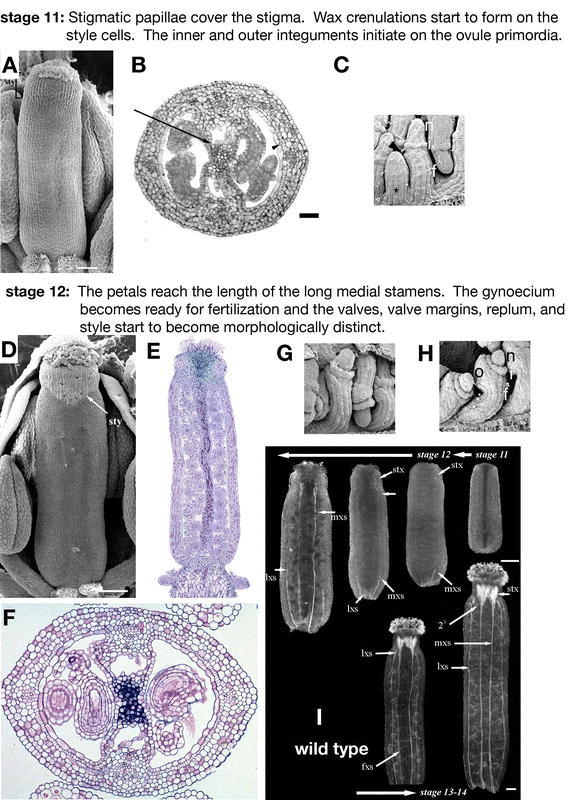Figure 6.

Flower development: stages 11–12. (A) SEM of a stage 11 gynoecium in which the stigma is covered with many papillae. (B) Cross-section of a stage 11 gynoecium. In the septum (arrow), small darkly staining cells near the middle of the gynoecium will form the transmitting tract. At the edges of the septum, large air filled pockets form with only a few loosely spaced cells. The cells in the enb layer have started dividing anticlinally to form long narrow cells (arrow head). (C) SEM of the ovule primordia in an early stage 11 gynoecium. The valve has been removed to expose the ovule primordia in one side of the gynoecium. The younger ovule primordium (asterisk) that forms a finger-like projection is typical of stage 10 while the slightly older ovule in which the inner integument (i) and outer integument (arrowhead) are initiating between the nucellus (n), and funiculus (f) is characteristic of the beginning of stage 11. (D) SEM of a mid stage 12 gynoecium where the stylar epidermal cells are clearly distinct from the rest of the gynoecium. (E) Longitudinal section of a stage 12 gynoecium. Note that the transmitting tract stains darkly. (F) Cross-section of a stage 12 gynoecium. The transmitting tract in the middle of the septum stains darkly. (G) SEM of the developing ovules early in stage 12, which have initiated inner and outer integuments. (H) SEM of the ovules inside the gynoecium midway through stage 12. The integuments have grown and start to cover the nucellus. (I) Cleared whole mount gynoecia viewed under dark field optics to visualize the thickening of the xylem cell walls. The progression of stages starts from the upper right, continues to the left, and curves around in the second row from left to right. At stage 11, no thickening of the xylem cell walls is detected. Early in stage 12, thickening begins at the base of the fruit in the medial xylem strands (mxs) and progresses apically. Then thickening begins in the stylar xylem (stx) and progresses toward the base in the medial vascular bundle. Later in stage 12, thickening of the lateral xylem strands (lxs) begins at the base of the fruit and develops toward the apex. Throughout stage 12 more xylem elements in the style differentiate. Additionally, a single strand of xylem differentiates in the funiculus (fxs). During stages 13 and 14, secondary (2°) vascular tissue forms in the valves branching from the lateral vascular bundle and differentiating toward the base of the gynoecium. Scale bars in A represent 50 µm, B 25 µm, and D and I 100 µm. A, B, D, and I: from Alvarez et al., 2002. C, G, and H: from Meister et al., 2002. E and F: Reprinted from Current Topics in Developmental Biology, 45, Bowman, J.L., Baum, S.F., Eshed, Y., Putterill, J., and Alvarez, J., Molecular genetics of gynoecium development in Arabidopsis, 155–205, Copyright (1999), with permission from Elsevier.
